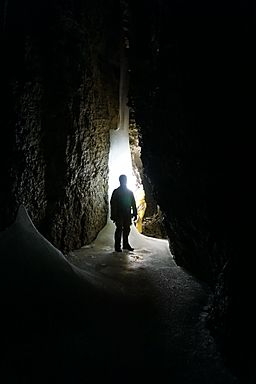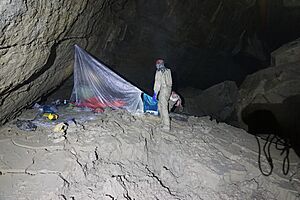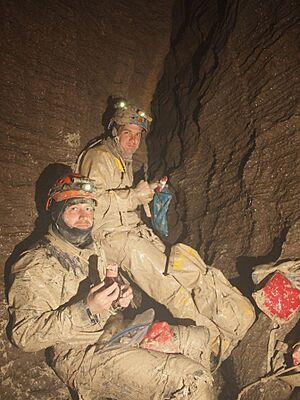Tears of the Turtle Cave facts for kids
Quick facts for kids Tears of the Turtle |
|
|---|---|
 |
|
| Location | Bob Marshall Wilderness |
| Depth | 1659 ft (506 m) |
| Length | 1.167 mi (1878 m) |
| Entrances | 1 |
| Hazards | Temperature, Vertical, Remote Location |
Tears of the Turtle Cave is a really deep cave found in the Bob Marshall Wilderness in western Montana. It's the deepest known limestone cave in the United States! In 2014, it became deeper than Lechuguilla Cave in New Mexico. As of 2016, the cave goes down 1,659 feet (506 meters) and stretches for about 1.32 miles (1,878 meters).
This cave is mostly made of narrow cracks, about 2 feet wide. Cavers have to go down many short rope drops to explore it. Inside, it's quite cold, around 39 degrees Fahrenheit (4 degrees Celsius). It's also muddy and doesn't have many fancy rock formations.
Contents
Exploring Tears of the Turtle Cave
The entrance to Tears of the Turtle Cave was first found in 2006. The cave passage is mostly a narrow crack, about two to three feet wide. It follows a stream as it goes deeper and deeper. Explorers have to use ropes for over 40 rappels (controlled descents).
Becoming the Deepest Cave
In 2014, a team of nine cavers explored new parts of the cave. They pushed it to a depth of 1,629 feet. This made Tears of the Turtle Cave the deepest known limestone cave in the United States! It passed New Mexico's Lechuguilla Cave.
Exploration kept going in 2016. Teams went back and pushed the cave even deeper, reaching its current known depth of 1,659 feet. These trips were so difficult that the cavers had to set up a camp inside the cave for the first time.
Challenges for Explorers
Exploring Tears of the Turtle Cave is very challenging. Cavers need special skills for all the rope work. The cave is also very cold, and it's in a remote location, far from roads or towns. These things make it hard to keep exploring. Still, another trip was planned for 2019 to find out more.
The ongoing exploration of this cave is part of the "Caves of Montana Project." This is an official project of the National Speleological Society. Cavers work with the United States Forest Service to make sure they explore safely and responsibly.
How the Cave Was Formed
Tears of the Turtle Cave is in a typical karst landscape. This means the area has special rock formations created by water dissolving rock. The cave itself formed in a type of rock called Cambrian Pagoda Limestone.
Over many years, rainwater and melting snow have slowly dissolved the limestone. This process created a solutional cave. It's a type of vadose cave, meaning it formed above the water table. The passages are mostly narrow cracks, about 2 to 3 feet wide, with tall ceilings.



